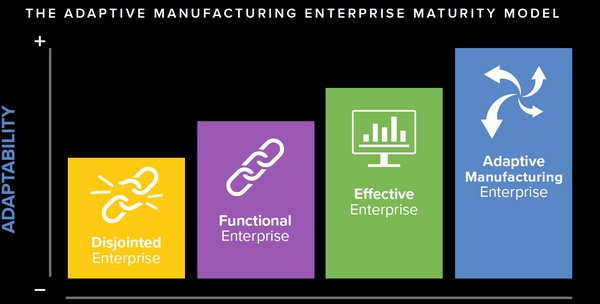Complimentary Adaptive Manufacturing Diagnostic helps companies gauge their ability to handle disruption
JAKARTA, Indonesia, Sept. 29, 2020 — QAD Inc. (Nasdaq: QADA) (Nasdaq: QADB), a leading provider of flexible, cloud-based enterprise software and services for global manufacturing companies, held QAD Tomorrow, a one-hour global thought stream that introduced the Adaptive Manufacturing Enterprise, QAD’s vision for manufacturing companies that are built to survive and thrive in the face of disruption. The company also announced the availability of the Adaptive Manufacturing Enterprise Maturity Model Diagnostic tool, which provides a method for manufacturers to gauge their preparedness to cope with disruption.

QAD held QAD Tomorrow, a one-hour global thought stream that introduced the Adaptive Manufacturing Enterprise, QAD’s vision for manufacturing companies that are built to survive and thrive in the face of disruption.
"Being prepared for the uncertain and the unforeseen, and ready to implement a rapid response to disruption, are critical for survival in today’s highly competitive and challenging world," said QAD CEO Anton Chilton. "Recent events have had a huge impact worldwide and underline the need to be ready to face these challenges however and whenever they manifest themselves. The ability to adapt in near real-time to these types of events is critical to a business’s success and even its survival. QAD engineers agile solutions that help manufacturers do exactly that. We call these companies Adaptive Manufacturing Enterprises."
QAD Tomorrow streamed globally September 22. The hour-long thought stream focused on the disruption in manufacturing and the imperative for manufacturers to digitally transform their businesses. Participants heard from QAD CEO Anton Chilton, CMO Carter Lloyds, CTO Tony Winter, and Michael Eckhardt from the Chasm Institute discussing the current trends disrupting industries worldwide and how manufacturers must be prepared to leverage disruption for competitive advantage.
"It was great to see registrations from 7 countries in South East Asia," said QAD Managing Director South Asia, Jan Biezepol. "It’s proof that South East Asia manufacturing companies recognize the need to increase their ability to adapt to disruption. This region has been resilient while facing global business disruptors including natural disasters, geopolitical disruption and now a pandemic. Our market leaders push towards becoming really fast, agile, and effective companies, and I am glad to share how QAD can help them do so."
The Adaptive Manufacturing Enterprise
QAD Tomorrow introduced the vision of the Adaptive Manufacturing Enterprise. Chilton discussed how Industry 4.0 and the increasing importance of digital transformation can help manufacturers adapt in response to internal and external disruptions, changes in customer preference and government regulations.
QAD’s Adaptive Applications portfolio of manufacturing solutions, including enterprise resource planning (ERP), demand and supply chain planning (DSCP), global trade and transportation execution (GTTE), and enterprise quality management systems (EQMS) is designed to help manufacturers become Adaptive Manufacturing Enterprises. Adaptive solutions can be modified, changed, extended, and adapted, as a company changes its business strategy in response to changes in the business climate.
The Adaptive Manufacturing Enterprise Maturity Model Diagnostic
QAD Tomorrow also debuted the Adaptive Manufacturing Enterprise Maturity Model Diagnostic, a complimentary diagnostic tool designed to help manufacturing companies gauge their ability to recognize and adapt to disruption. The Adaptive Manufacturing Enterprise Maturity Model Diagnostic tool helps companies identify their business’s strengths and potential weaknesses in the context of business disruption. It places companies in one of four stages along what QAD calls the Adaptive Manufacturing Enterprise Maturity Model. Each stage, Disjointed Enterprise, Functional Enterprise, Effective Enterprise, and Adaptive Manufacturing Enterprise, describes certain characteristics related to a company’s ability to cope with disruption.
The results of the Adaptive Manufacturing Enterprise Maturity Model Diagnostic can help manufacturing companies begin to answer the following questions:
- What does my company need to do to prepare for and manage disruption?
- How does my company compare to an ideal Adaptive Manufacturing Enterprise?
- What does my company need to do to become an Adaptive Manufacturing Enterprise?
You can watch a recording of QAD Tomorrow-VDO stream here. For more information regarding the Adaptive Manufacturing Enterprise or the Adaptive Manufacturing Enterprise Maturity Model, please visit https://www.qad.com/adaptive-manufacturing-enterprise/diagnostic
email: [email protected] or call 021 3973 8908
About QAD – Enabling the Adaptive Manufacturing Enterprise
QAD Inc. is a leading provider of adaptive, cloud-based enterprise software and services for global manufacturing companies. Global manufacturers face ever-increasing disruption caused by technology-driven innovation and changing consumer preferences. To survive and thrive, manufacturers must be able to innovate and change business models at unprecedented rates of speed. QAD calls these companies Adaptive Manufacturing Enterprises. QAD solutions help customers in the automotive, life sciences, consumer products, food and beverage, high tech and industrial manufacturing industries rapidly adapt to change and innovate for competitive advantage.
Founded in 1979 and headquartered in Santa Barbara, California, QAD has 29 offices globally. Over 2,000 manufacturing companies have deployed QAD solutions including enterprise resource planning (ERP), demand and supply chain planning (DSCP), global trade and transportation execution (GTTE), and quality management system (QMS) to become an Adaptive Manufacturing Enterprise. To learn more, visit www.qad.com or call +1 805-566-6100. Find us on Twitter, LinkedIn, Facebook, Instagram, and Pinterest.
"QAD" is a registered trademark of QAD Inc. All other products or company names herein may be trademarks of their respective owners.
Note to Investors: This press release contains certain forward-looking statements made under the "safe harbor" provisions of the Private Securities Litigation Reform Act of 1995, including, but not limited to, statements regarding projections of revenue, income and loss, capital expenditures, plans and objectives of management regarding the company’s business, future economic performance or any of the assumptions underlying or relating to any of the foregoing. Forward-looking statements are based on the company’s current expectations. Words such as "expects," "believes," "anticipates," "could," "will likely result," "estimates," "intends," "may," "projects," "should," "would," "might," "plan" and variations of these words and similar expressions are intended to identify these forward-looking statements. A number of risks and uncertainties could cause actual results to differ materially from those in the forward-looking statements. These risks include, but are not limited to: risks associated with the COVID-19 (novel coronavirus) pandemic or other catastrophic events that may harm our business; adverse economic, market or geo-political conditions that may disrupt our business; our cloud service offerings, such as defects and disruptions in our services, our ability to properly manage our cloud service offerings, our reliance on third-party hosting and other service providers, and our exposure to liability and loss from security breaches; demand for the company’s products, including cloud service, licenses, services and maintenance; pressure to make concessions on our pricing and changes in our pricing models; protection of our intellectual property; dependence on third-party suppliers and other third-party relationships, such as sales, services and marketing channels; changes in our revenue, earnings, operating expenses and margins; the reliability of our financial forecasts and estimates of the costs and benefits of transactions; the ability to leverage changes in technology; defects in our software products and services; third-party opinions about the company; competition in our industry; the ability to recruit and retain key personnel; delays in sales; timely and effective integration of newly acquired businesses; economic conditions in our vertical markets and worldwide; exchange rate fluctuations; and the global political environment. For a more detailed description of the risk factors associated with the company and factors that may affect our forward-looking statements, please refer to the company’s latest Annual Report on Form 10-K and, in particular, the section entitled "Risk Factors" therein, and in other periodic reports, the company files with the Securities and Exchange Commission thereafter. Management does not undertake to update these forward-looking statements except as required by law.
Photo – https://photos.prnasia.com/prnh/20200928/2930156-1-a?lang=0
Photo – https://photos.prnasia.com/prnh/20200928/2930156-1-b?lang=0







